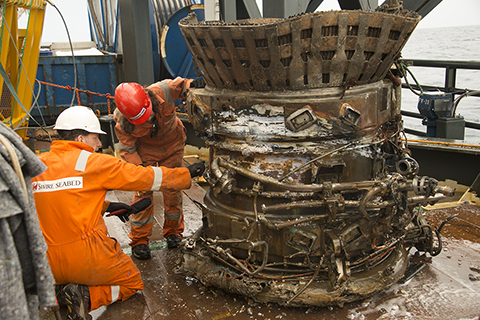Using caves on the Moon for habitats plays a part in science fiction and possibly for real if we ever go back to stay. Finding them and checking out their usefulness will be necessary and Jaro alerted me to the below PDF article.
When you decide to move it will take a bit of fixing up and I have been viewing some videos of Neri Oxman of MIT's Media Lab using 3D printers. Could I use any of her ideas. Look around and see what mother nature has done and be inspired and creative.
- LRK -
------------------------------
44th Lunar and Planetary Science Conference (2013) - 3080.pdf
SKYLIGHT: MISSION TO INVESTIGATE AND MODEL A LUNAR PIT. H. L. Jones1, K. M. Peterson2, W. L. Whittaker1,2, and U. Y. Wong1 1Robotics Institute, Carnegie Mellon University (5000 Forbes Ave, Pittsburgh, PA 15213, {hlj|red|uyw}@cs.cmu.edu), 2Astrobotic Technology, Inc. (2515 Liberty Ave, Pittsburgh, PA 15222, kev-in.peterson@
Introduction: Caves on planetary bodies beyond Earth have always been of great interest for science and exploration, but for many years there was no known way to enter. Unprecedented high-resolution imagery from the Lunar Reconnaissance Orbiter has revealed pits that are believed to be skylights – features formed by partial cave ceiling collapse that provide access into caves [1],[2]. Skylights have also been discovered on Mars [3], and similar features may exist elsewhere in the solar system [1]. Discovery of these features changes everything. The Skylight mission takes the next step to closely investigate one of these pits.
Mission Objectives: The Skylight mission seeks to answer science and exploration questions about the-se newly discovered lunar skylights. The objectives of the mission are to:
1. provide multi-perspective close-up images of a lunar pit,
2. build a detailed, high quality 3D model of the pit, and
3. survey the terrain surrounding the pit.
Mission Decription: The Skylight mission targets the Marius Hills Hole (MHH) in the Marius Hills re-gion of Oceanus Procellarum at 14.2°N, 303.3°E [4]. This pit is selected because of its location on the lunar near side, facilitating mission operations without re-quirement for installation of expensive communication infrastructure, as well as the indications of lava tubes in surrounding terrain.
snip
------------------------------
Neri Oxman
- LRK -
------------------------------
Neri Oxman, Founder of Mediated Matter Lab -- Part 1
Published on Feb 20, 2013
Neri Oxman, Founder of Mediated Matter Lab -- Part 1...
Material Ecology - http://web.media.mit.edu/~
MIT - http://www.media.mit.edu/
Wikipedia - http://en.wikipedia.org/
Material Ecology - http://web.media.mit.edu/~
MIT - http://www.media.mit.edu/
Wikipedia - http://en.wikipedia.org/
snip
------------------------------
What might you be able to create with nature in mind.
- LRK -
------------------------------
Architect Neri Oxman is the founder of MATERIALECOLOGY, an interdisciplinary design initiative expanding the boundaries of computational form-generation and material engineering. Named one of Fast Company's "100 Most Creative People in Business," Oxman investigates the material and performance of nature in an effort to define form itself.
snip
Or on YouTube - https://www.youtube.com/
Uploaded on Mar 12, 2010
Architect Neri Oxman is the founder of MATERIALECOLOGY, an interdisciplinary design initiative expanding the boundaries of computational form-generation and material engineering. Named one of Fast Company's "100 Most Creative People in Business," Oxman investigates the material and performance of nature in an effort to define form itself.
Category
License
Standard YouTube License
------------------------------
What could you do with the 3D printer?
- LRK -
------------------------------
Revolution in Art & Design using 3D Printing | Objet for Neri Oxman
Published on May 4, 2012
As seen on the Objet blog: http://blog.objet.com/
A special thanks to MIT Media Lab's Neri Oxman, Peter Schmitt (3D printed clock) & Amit Zoran (3D printed flute) for kindly allowing footage of their 3D printed models to be used in the making of this film. (Some of these parts were created using a variety of 3D printing technologies including Objet.)
A special thanks to MIT Media Lab's Neri Oxman, Peter Schmitt (3D printed clock) & Amit Zoran (3D printed flute) for kindly allowing footage of their 3D printed models to be used in the making of this film. (Some of these parts were created using a variety of 3D printing technologies including Objet.)
In this insightful interview, Neri Oxman,architect, designer and professor of Media Arts and Sciences and Director of the Mediated Matter group at the MIT Media Lab, explains the differences between 'additive' and 'subtractive' manufacturing. Inspired by things that 'grow' in nature, Oxman uses the world's most advanced 3D printing technology - the Objet Connex500 multi-material 3D printer to produce some incredible models which will be on display at the Pompidou Center until August 6th 2012 at the 'Multiversites Creatives' exhibit. Neri also explains 3D printing within the wider paradigm shift in technology and manufacturing - comparing it to the Gutenberg 2D print revolution of the 1440's.
For more information about Objet: http://www.objet.com/
Category
License
Standard YouTube License
snip
------------------------------
Feel free to express yourself.
Could you design a pair of space suit gloves that would not wear out an astronaut's fingernails?
- LRK -
------------------------------
Neri Oxman, Founder of Mediated Matter Lab -- Part 2
Published on Feb 20, 2013
Neri Oxman, Founder of Mediated Matter Lab -- Part 2... The Next List: CNN's hub for stories about innovation.
Material Ecology - http://web.media.mit.edu/~
MIT - http://www.media.mit.edu/
Wikipedia - http://en.wikipedia.org/
The Next List: http://whatsnext.blogs.
Material Ecology - http://web.media.mit.edu/~
MIT - http://www.media.mit.edu/
Wikipedia - http://en.wikipedia.org/
The Next List: http://whatsnext.blogs.
Category
License
Standard YouTube License
snip
------------------------------
Feel free to think outside the box, inside the box, on the box, and really not so boxy in the first place. :-)
Thanks for looking up with me.
- LRK -
Web Site: http://lkellogg.vttoth.
BlogSpot: http://
WordPress: http://lrkellogg.
Newsletter: https://mailman1.
BlogSpot: http://
WordPress: http://lrkellogg.
Newsletter: https://mailman1.
=========================================
WHAT THE MIND CAN CONCEIVE, AND BELIEVE, IT WILL ACHIEVE - LRK -
==============================








